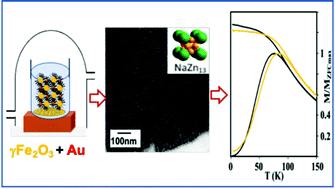Structural diversity in binary superlattices from Au and γ-Fe2O3 nanocrystals: towards fine tuning of dipolar interactions†
Abstract
Two cooperative and complementary components such as γ-Fe2O3/Au nanoparticles (NPs) are used to grow binary superlattices (BNSLs). The effects of different parameters including concentration ratio of colloidal solutions, effective size ratio of NPs, deposition temperature and type of solvent on the formation of BNSLs are discussed. A systematic study of the effect of these parameters is performed to determine the driving forces underlying the BNSL formation. We show that by using the same batch of particles, the control of the various parameters gives rise to a large diversity of crystalline structures. In addition, thanks to their long-range organization, the magnetic properties of γ-Fe2O3/Au NPs binary superlattices are studied by SQUID magnetometry and compared to those of pure γ-Fe2O3 NPs superlattices. The γ-Fe2O3 interparticle distance modulated by the insertion of Au NPs is shown to significantly impact their magnetic properties.



 Please wait while we load your content...
Please wait while we load your content...